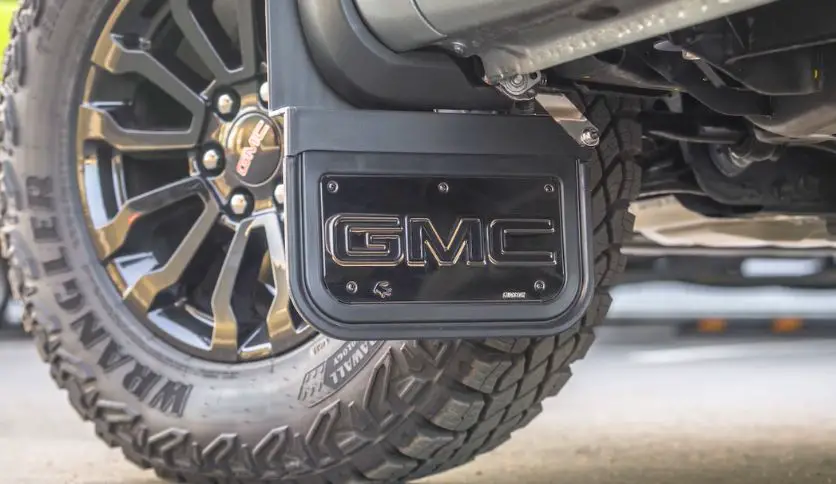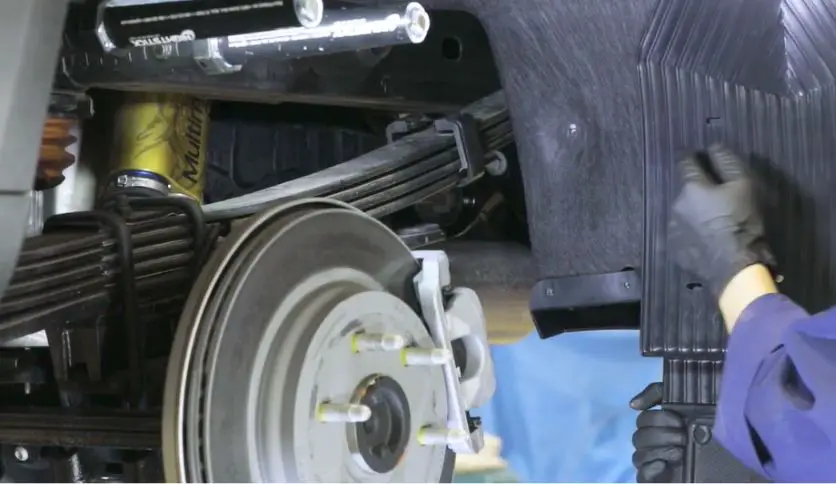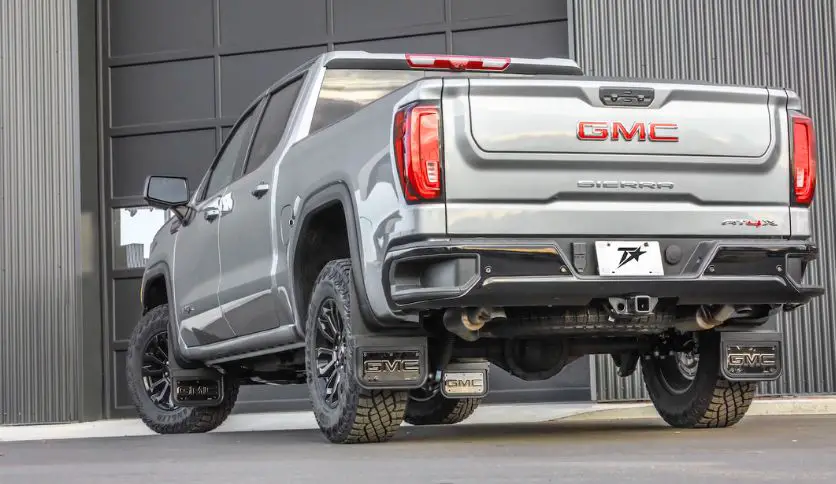When it comes to maintaining your GMC Sierra 1500, one of the most overlooked accessories that can make a significant difference is a good set of mud flaps. Not only do they protect your truck from mud, rocks, and road debris, but they also add a touch of personal style. In this guide, we’ll walk you through the process of choosing the perfect size mud flaps for your Sierra 1500, ensuring your ride stays clean and protected.
Contents
What Are Mud Flaps?
Mud flaps, also known as splash guards, are panels that hang behind the wheels of your vehicle. They serve as a barrier between the tires and the wheel well, catching all sorts of debris that could chip the paint or cause corrosion over time.
Benefits of Installing Mud Flaps on Your GMC Sierra 1500
Installing mud flaps on your Sierra 1500 can significantly reduce the amount of spray and debris that hits the lower body of your truck. This not only keeps your truck cleaner but also minimizes the risk of rust and damage to the undercarriage.
The GMC Sierra 1500 Specifications

Overview of the GMC Sierra 1500
The GMC Sierra 1500 is known for its rugged build and versatility. Whether you’re hauling heavy loads or cruising on the highway, this truck is designed to handle it all with ease.
Wheel and Tire Dimensions
The Sierra 1500 comes with various wheel and tire sizes, which are essential to know when selecting mud flaps. Make sure you have your specific tire size handy, as this will be crucial in choosing the right mud flaps.
Tools Needed for Measuring
Before you start, you’ll need a tape measure and a notepad to jot down the measurements. A level surface is also ideal for getting accurate measurements.
Step-by-Step Measuring Guide
Before you begin, ensure you have a sturdy tape measure, a notepad for recording your measurements, and possibly a friend to help you ensure accuracy. It’s essential to perform these measurements with precision, as they will determine the fit and effectiveness of your mud flaps.
1. Park Your Sierra 1500 on a Level Surface
Find a flat and level area to park your truck. This ensures that your vehicle is stable and that your measurements will be accurate. Uneven ground can lead to incorrect measurements, which in turn can result in ill-fitting mud flaps that don’t provide adequate protection.
2. Measure the Width of Your Tires
With your Sierra 1500 parked, take your tape measure and extend it across the breadth of your tire. You’ll want to measure the full width, from the outer edge on one side to the outer edge on the other. This measurement is crucial because the mud flaps need to be wide enough to cover the full width of your tires to block and deflect debris effectively.
3. Measure the Height from the Top of the Tire to the Lowest Point of the Vehicle Body
Next, you’ll measure the height for the mud flaps. Place the end of your tape measure at the top center of the tire and extend it vertically upwards to the lowest point of the vehicle body where the mud flap will be attached. This is typically just beneath the fender. This measurement ensures that the mud flap can hang sufficiently low to protect your truck but not so low that it drags on the ground or interferes with the tire’s movement.
4. Note the Distance from the Tire’s Edge to the Point Where the Mud Flap Will Hang
For the final measurement, you need to determine how far out from the tire’s edge the mud flap should hang. Measure from the edge of the tire (where the tread ends) straight out to the point where the mud flap will be installed. This distance is important because if the mud flap is too close to the tire, it won’t provide adequate coverage, and if it’s too far, it could catch on obstacles or debris.
Additional Tips:
- Double-Check Your Measurements: It’s always a good idea to measure twice to ensure accuracy.
- Consider Wheel Well Clearance: Make sure there’s enough space within the wheel well to accommodate the mud flap without it rubbing against the tire when it’s fully loaded or when the suspension is in motion.
- Account for Different Tire Sizes: If you’ve customized your Sierra 1500 with aftermarket tires that are larger or smaller than the stock size, adjust your measurements accordingly.
- Check for Pre-Drilled Holes: Some mud flaps come with pre-drilled holes for mounting. If yours do, ensure that your measurements align with these holes.
By following this detailed measuring guide, you’ll be able to choose mud flaps that fit perfectly, offering the best protection for your GMC Sierra 1500. Remember, the right fit not only adds to the aesthetic appeal of your truck but also ensures that the mud flaps perform their function effectively, keeping your vehicle clean and safeguarded against the elements and road debris.
Choosing the Right Size Mud Flaps
Size Variations and What They Mean
Mud flaps come in various sizes. For full-sized trucks like the Sierra 1500, you’ll generally want larger flaps that offer ample coverage.
Compatibility with GMC Sierra 1500
Ensure the mud flaps you choose are compatible with your truck’s model year. Some flaps are universal, while others are custom-fit for specific models and years.
Step-by-Step Installation Guide

Installing mud flaps on a GMC Sierra 1500 might seem like a straightforward task, but it requires attention to detail to ensure a secure and proper fit. Here’s how you can do it:
1. Align the Mud Flap to the Wheel Well
Before you start drilling any holes, it’s crucial to align the mud flap to the wheel well where it will be attached. Hold the mud flap up against the wheel well and adjust it so that it’s centered over the width of the tire and has the proper clearance from the ground. The bottom edge of the mud flap should be parallel to the ground, and there should be a few inches of clearance to prevent dragging.
2. Mark the Spots for the Screws
Once the mud flap is aligned correctly, use a marker or a piece of chalk to mark the spots on the vehicle’s body where the screws will go. These marks are your drilling targets. Make sure that the marks are in the appropriate places according to the mud flap’s pre-drilled holes, if it has any, or where the screws will provide the most secure fit.
3. Drill Holes Carefully, Ensuring They Line Up with the Marks
After marking the spots, remove the mud flap and get ready to drill. Using a drill with the appropriate size bit, carefully drill holes where you’ve made your marks on the vehicle’s body. It’s essential to drill perpendicularly to the surface to ensure the screws will go in straight. Take your time with this step to prevent any mistakes that could damage your vehicle or cause the mud flaps to be misaligned.
4. Secure the Mud Flap with Screws, Double-Checking for a Snug Fit
With the holes drilled, it’s time to attach the mud flap. Line up the holes in the mud flap with the holes you’ve drilled in the vehicle’s body. Start by hand-threading the screws to ensure they fit correctly. Once all screws are in place and aligned, use a screwdriver or a drill with a screw bit to tighten them. Be careful not to over-tighten, as this could strip the holes or damage the mud flap. The mud flap should be firmly attached but still have a little bit of give to allow for some movement.
Additional Installation Tips:
- Use the Right Tools: Ensure you have a drill, the correct drill bits, screws, a screwdriver, and possibly a rivet gun if your installation requires rivets.
- Protective Coating: Consider applying a bit of anti-corrosion spray or paint on the exposed metal after drilling to prevent rust.
- Check Alignment: After the mud flap is secured, step back and check to ensure it’s still properly aligned. The mud flap should be perpendicular to the ground and cover the tire’s width.
- Test for Clearance: Turn the wheel to the extreme left and right to ensure that the mud flap doesn’t rub against the tire or the wheel well.
- Repeat for All Tires: Follow the same process for each wheel, ensuring consistency in placement and height.
By following these detailed steps, you can install mud flaps on your GMC Sierra 1500 with confidence, knowing they’re well-aligned and securely attached. Proper installation will not only enhance the look of your truck but also ensure maximum protection from road debris and the elements.
Maintenance and Care
Cleaning Your Mud Flaps
Regular cleaning with soap and water will keep your mud flaps looking new. Avoid using harsh chemicals that can degrade the material.
Regular Checks and Replacements
Inspect your mud flaps periodically for any signs of wear or damage. If they start to crack or tear, it’s time for a replacement.
Conclusion
Choosing the best mud flaps for your GMC Sierra 1500 is a simple yet essential step in maintaining your truck’s appearance and integrity. With the right measurements and a bit of know-how, you can select, install, and maintain the perfect mud flaps that will keep your Sierra looking great and protected from the rigors of the road.

Hello, this is Wesley Shelton, currently working in a car restoration company for over 5 years. Before that, I was a worker at a small car repair shop. As I was a car freak from a young age and worked as a professional for over half a decade, I think I now know pretty much everything about every car and its parts. To establish my name as a professional and help others by sharing my knowledge, I’ve created this website, which I work on whenever I get free time. I hope you’ve enjoyed my informative blog!


